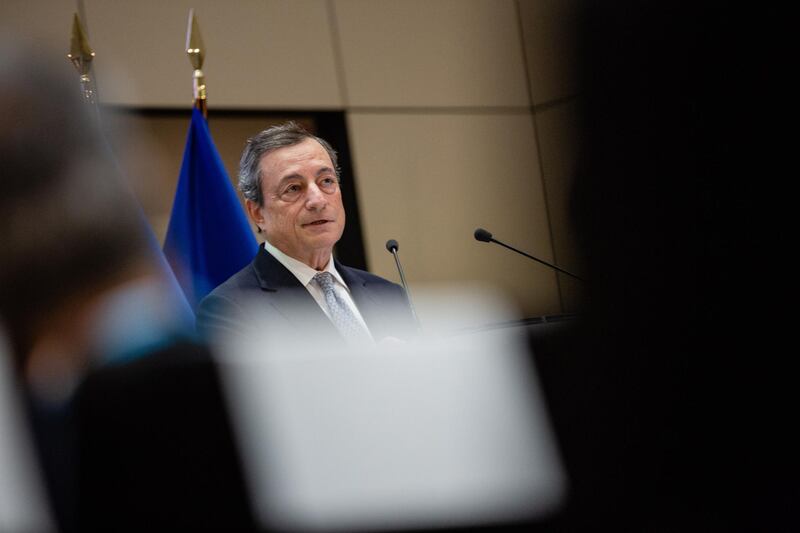European Central Bank officials are starting to discuss priming investors for the euro area’s first interest-rate increase since 2011, a conversation that could see them putting the US experience of three years ago under the microscope.
With the Governing Council indicating borrowing costs will stay at record lows “at least through the summer of 2019,” two of President Mario Draghi’s lieutenants are already talking about what happens after that. Executive Board members Benoit Coeure and Peter Praet want to communicate more on the pace of increases to avoid stirring up markets.
Concerns over the impact of tighter policy are likely heightened by the memory of the two increases in 2011 being swiftly undone as the euro zone tipped into recession. Officials insist the economy is now strong enough to face global risks from trade protectionism to Brexit, but also regularly cite market volatility as a risk. That makes a so-called dovish hike an attractive goal.
“What they are trying to communicate to investors is that the lift-off is going to be slow,” says Nick Kounis, head of macro and financial markets research at ABN Amro Bank in Amsterdam. “The ECB has learned its communication lesson from the Federal Reserve, and they want to make sure well ahead of time that markets are clear on their thinking.”
Policy makers are not all on the same page though. Governing council member Ewald Nowotny, Austria’s central-bank chief, said on Sunday that officials should “ask if it’s really sensible” to lock in record-low rates for so long. Mr Draghi may be quizzed on his view when he testifies to the European Parliament next week.
_________
Read more:
Central Banks strike back against meddling
No-deal Brexit means interest rate rises, says Bank of England chief
Are these the warning signs of an approaching global recession?
Nine lessons from the global financial crisis
__________
The Fed was widely lauded when it raised rates in December 2015 under then-chair Janet Yellen,. After a rocky start in May 2013, when she was vice chair and her boss, Ben Bernanke, spooked investors by unexpectedly suggesting asset purchases might be tapered, the central bank successfully reached lift-off with barely a murmur of discontent in the markets.
The strategy was a series of incremental language changes, ranging from subtle to blatant, that signalled a rate hike was getting closer. As asset purchases ended in October 2014, the Fed said rates would stay near zero for a “considerable time.” That was dropped in January 2015 as the economy improved, though policy makers cautioned they’d remain “patient.”
In March, they pinned a hike on “further improvement in the labour market.” By July, a tweak to say the Fed awaited “some” further improvement in the labour market was a one-word addition that inched them toward liftoff. Officials finally teed up the decision in their October statement with an unusual reference to their “next meeting.”
Mr Praet, the ECB’s chief economist, told an audience in New York last week that communication on how to adapt policy beyond the first rate hike will become “increasingly important” next year.
Mr Coeure, who is in charge of market operations and is a potential successor to Mr Draghi in November 2019, said in Berlin that he would prefer to outline the economic conditions that justify higher borrowing costs.
He rejected publishing an expected path of interest rates, as Sweden’s Riksbank does. The Fed uses a so-called dot-plot chart compiling anonymous predictions by policy makers for how fast they expect rates to rise.
The Norwegian central bank showed last week how the pace of monetary tightening can matter more for markets than the actual timing of the first move. The krone dropped after governor Oystein Olsen raised rates for the first time in seven years and lowered his projection for how fast they’ll climb in the years ahead.
The Bank of England, which in August raised its benchmark rate to the highest since the financial crisis, takes a milder approach, coloured by the uncertainties surrounding the UK’s departure from the European Union. It says future increases in the key rate will be “at a gradual pace and to a limited extent.”
The process never stops. The Fed is currently wrestling with the question of where to end tightening, and chairman Jerome Powell is considering how to change communication.
“If the ECB wants to be in control, the sooner they start talking about their plans the better,” says Anatoli Annenkov, senior economist at Societe Generale in London. “There are sufficient reasons to believe that at times the communication is quite difficult and markets may not believe you.”
* Bloomberg






